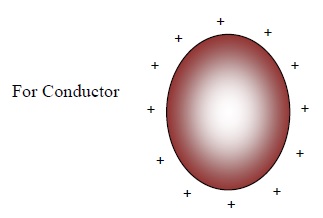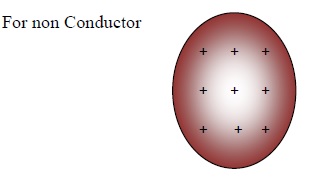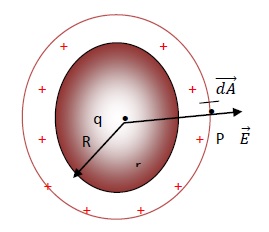Electric Field Due to Shell of Charge
Description:
We already know the Electric field due to charge distributed in a straight line and in a plane as well. Now we will find Electric field due to charge distributed over a sphere. The charge distributed over the sphere has two categories −
- Charge distributed over a shell or a conducting sphere
- Charge distributed in a non conducting sphere
Charge distributed over a shell or a conducting sphere
In case, charge is given to the shell, then all the charge gets distributed over the surface due to repulsion between the charges.
Even in case of a conducting sphere (Say sphere made of metal), If at any place the charge is given, then due to repulsion all the charges comes over the surface of the conductor.
In both the cases ( either the case of shell or a conducting sphere) it is common that charges remains on the surface. so, Charge distributed over a shell or a conducting sphere can be called either shell of a charge or a conducting shell.
Electric field due to shell of charge

Charge distributed in a non conducting sphere
If charges are given to a non conducting sphere, then even after repulsion between the charges, they are not allowed to move over the surface. So charges remain inside.It is same as in case of friction between the two clouds. Due to friction, a lot of charge is generated. But because cloud is a bad conductor so charge does not come over the surface but gets distributed within the cloud.
So, For both the cases, all the measurements are done differently.
In case of a shell, since the charge is on the surface so distribution is called areal distribution Of charges. σ charge per unit area will be used.
Similarly In the case of a non conductor, the charge is inside the volume so distribution is called volumetric distribution of charge . ρ charge per unit volume will be used.

Electric Field due to shell of charge
Take a shell of charge with total charge on it be ‘q’ and the areal charge density be ‘σ’. Let R be the radius of the shell. We need to calculate electric field due to a conducting shell at point ‘P’ using gauss theorem.
Divide the location into 3 classes −
- If the point is outside the sphere
- if the point is on the surface of the sphere
- If the point is inside the sphere.
Case 1
Step 1
Let the point ‘p’ be outside the charged shell at a distance ‘r’ from its centre and we need to find Electric field at that point.
Consider a Gaussian surface in form of a concentric sphere of radius ‘r’ so that it passes through ‘P’. E is radial (perpendicular to charged surface) with same distance to Gaussian surface. It is symmetrical at every point and area vector A makes 0. At every point.

Step 2
We know
∮ E.dScos θ = q/ ε0
On putting the value of θ = 0. In LHS We get −
∮ E.dScos θ = E ∮ dS
When the complete area is added up we get 4πr2 so, on integrating within the limit (0-4πr2) we get −
∮ E.dScos θ = E ∮ dS = 4Eπr2
Step 3
Charge within the Gaussian surface = q
Step 4
Apply Gauss Theorem −
∮ E→.dS→ = q/ ε0
Now, putting values in the equation we get −
4Eπr2 = q/ ε0
So, E = 14πε0 qr2
This is the electric field at distance ‘r’ due to a shell of charge.
For a point charge q, Electric field at a distance r, is also E = 14πε0 qr2
So we can say that the Charge on a shell behaves like a point charge kept at centre of it. It is true only when the electric field is outside the shell.
Case 2
We have seen that the electric field is outside the shell E ∝ 1/r2 i.e on decreasing the distance, electric field becomes stronger. So on the surface of the shell, where the distance is minimum, we get the maximum value of electric field (Emax).
On the surface of the shell Emax = 14πε0 qR2

